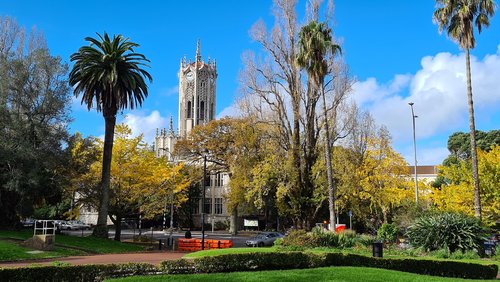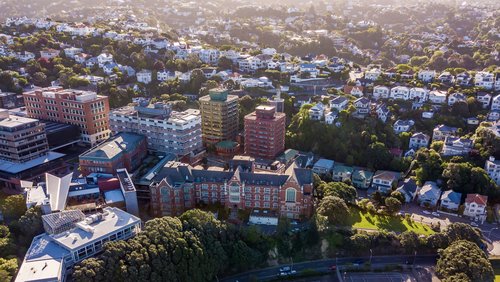12 Jun 2023
In the wake of catastrophic weather events in New Zealand, how do we engineer our way forward?
In late January, the Auckland anniversary weekend floods and, just a fortnight later, Cyclone Gabrielle wreaked catastrophic destruction on an already sodden North Island. They came after a summer of storms and Cyclone Hale. Sadly, the wild weather claimed lives, deemed thousands of homes uninhabitable and ruined livelihoods. Flooding, fallen trees and slips saw hundreds of roads closed and communities cut off.
This decade has already seen record-breaking storms. Massive floods caused widespread destruction in Nelson-Marlborough and the West Coast – in July 2021 and again in August 2022.
Cyclone repair costs are estimated at $13 billion and it will take years to build back. Post-Cyclone Gabrielle, it is a pivotal time for the country’s infrastructure planning, as New Zealand looks to build back better while preparing our cities and urban areas for future events.
Time for much-needed change
A more resilient future will require “revolutionary changes” – and there’s no better time to make these than straight after a disaster, says University of Auckland senior lecturer in civil and environmental engineering, Dr Sandeeka Mannakkara MEngNZ.
Sandeeka, who specialises in post-disaster recovery and reconstruction, city resilience and climate change adaptation, says while the weather events were “absolutely awful”, it’s the best time to make much-needed change.
“There are resources, there’s interest, there’s motivation – everybody’s on board.”
Sandeeka says to truly prepare, it’s important to “really understand” what it takes to build back better in this era of climate change.
This requires a three-step process.
- Acknowledge existing climate change prediction models and utilise them, looking into all possibilities of risk under different emissions scenarios, and updating anticipated risk levels accordingly.
- Undertake an extensive stocktake of current infrastructure and the existing built environment, to see what capacity it has in relation to these new risk levels.
- Commit to putting resources into upgrading infrastructure to the necessary standards, or “make some tough decisions” about what needs to change.
With the unpredictability resulting from climate change, it is crucial to take a “resilience network approach” to infrastructure and urban planning, as a way of dealing with “unknown unknowns”.
... you’re no longer trying to completely defend or protect yourself from nature, but rather working in an adaptive way.
This requires rethinking all options, from road networks to electricity, communications and water.
“If one part of this doesn’t work, then how do we still serve the community? This is a resilient space where you’re no longer trying to completely defend or protect yourself from nature, but rather working in an adaptive way. It’s about figuring out other means of getting by.”
This approach could involve working with urban planners more collaboratively, as well as being open to a Te Ao Māori approach, which is “very adaptive. It doesn’t try to go against nature or try to contain it”.
Post-Cyclone Gabrielle, Sandeeka noticed a wider willingness to acknowledge the urgency of climate change, and ideas of adaptation and risk. She hopes this will translate into more resources where climate adaptation is needed.
“Previously, when certain climate change adaptation solutions were proposed, there has been resistance due to the lack of urgency and allocation of resources. Issues like managed retreat were difficult to discuss because people just didn’t think it was necessary. These events have helped bring those conversations to light. Hopefully, they’re changing everyone’s mindset.”
Stormwater management and design
The Auckland floods in late January were an “extraordinary, out-of-design event”, says civil engineer Allan Leahy FEngNZ, Principal – Growth Planning, for Auckland Council Healthy Waters.
Tāmaki Makaurau saw 249mm of rain fall over 24 hours – well above the previous record of 161.8mm – and groundwater levels reached record highs.
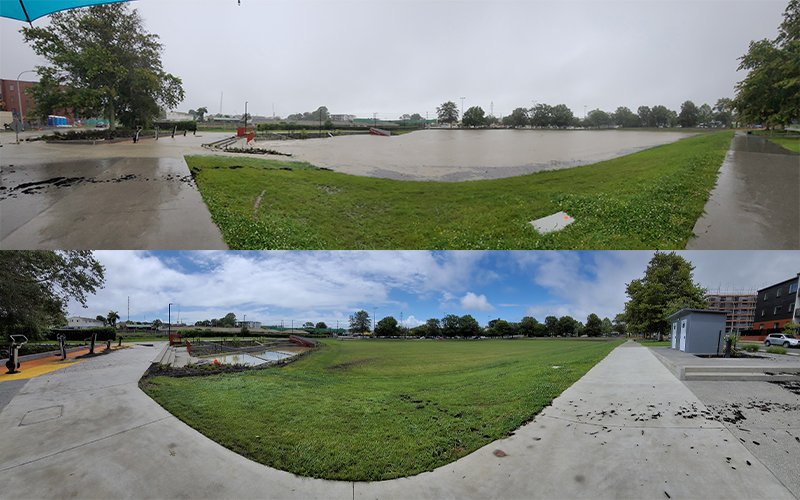
Greenslade Reserve in Northcote during severe weather on 27 January, and on 28 January once floodwaters had drained away. Photos: Allan Leahy FEngNZ
“A bad storm would normally affect just one or a few catchments within the city, but up to 60 percent of the city was affected by extreme rainfall on 27 January, an event greater than a one percent event – a storm that has a one-in-100 chance of occurring in any one year.”
Parts of Auckland fared better than others. What didn’t work so well included “non-integrated” developments, both historical and recent, with depressions that filled or floodplains that flooded homes. Older suburbs especially in soakage areas, originally laid out at a time with less emphasis on overland flow path design, which have since undergone intensification, were also affected.
What did perform well were “integrated” developments – those which incorporate water-sensitive design holistically, where water is designed to pond or flow in certain places, away from houses.
The former Air Force base at Hobsonville Point, developed with overland flow paths and floodplains, the old Mount Wellington quarry Stonefields, constructed around a floodable park, and Greenslade Reserve in Northcote combined with downstream naturalisation, all performed well in the event with little or no flooding reported.
As older areas of Tāmaki Makaurau come up for redevelopment, it’s “really important” that they’re developed in an integrated way to minimise this risk.
In terms of stormwater management this means, Allan says, “defining how we manage those regular flows – can we still rely on soakage systems, are our pipe systems adequate? How do we manage the secondary flows, do we have secondary flow paths, if not, can we create them? Are we safely managing the risk to the people in and around those depressions?”
Following nature
As seen in Auckland, the use of nature-based solutions could prove an adaptive and effective way to build resilience, says ecological engineer Stu Farrant MEngNZ. These either “rely on, or mimic, natural processes to mitigate adverse impacts, protect communities and enhance urban ecology," says Stu.
“Nature-based solutions support our human changes in the landscape, while ensuring those landscapes and the people who live in them are resilient; both in terms of the ecosystem function, as well as the community and cultural values that natural systems support.”
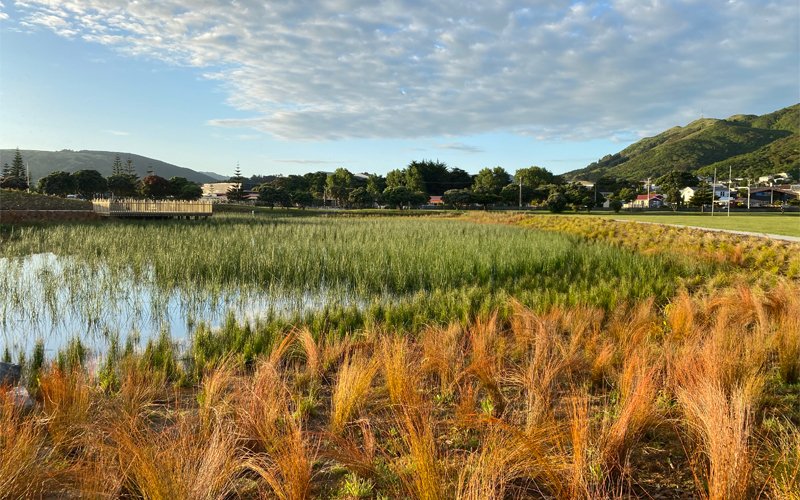
Te Kukuwai o Toa wetland in Porirua, Wellington, combines water quality with flood protection, amenity and urban biodiversity. Photo: Stu Farrant MEngNZ
Similar to terms such as water-sensitive design, green infrastructure and low-impact design, nature-based solutions can include constructed wetlands, rain gardens, rainwater tanks, green roofs, urban waterways and urban trees.
Stu notes that the term “sponge cities”, which came out of China following Beijing’s deadly 2012 floods, has been somewhat misused recently as a simplification of the challenges with urban water under a changing climate. Rather than a sole focus on permeable land cover, it is intended as a broad term for city-wide integrated water management.
“The name says it all – a sponge has a finite limit to it, at which point the water sheds off.”
Designing parks and sports fields with stormwater treatment and detention capacity during big rainfall events is an example of how infrastructure can serve the community in more than one way.
“It can protect the environment and connect the community with water; it deals with regular rain but then in the very large events, it’s also part of how the landscape responds to that as well.”
Stu, who is the Water Sensitive Design lead at environmental consultancy Morphum, says engineers have a fundamental role to play in building resilience into infrastructure using nature-based solutions. It’s important for designers to step back and look at the project holistically at the start. It is possible to build in resilience retrospectively, but, as with most things it’s easier and more cost effective to do it first.
We have an opportunity to start taking action now that will really pay dividends in 30 or 50 years’ time.
“Consideration also needs to go into how something will cope with a range of changing climatic conditions.”
Many nature-based solutions take time to establish and thrive so it’s important to recognise where we have got some time on our hands, particularly with issues like urban heat, he says.
“We have an opportunity to start taking action now that will really pay dividends in 30 or 50 years’ time.”
Building better housing
In the wake of Cyclone Gabrielle, New Zealand has a huge opportunity to advance the types of housing constructed and created, says New Zealand Green Building Council (NZGBC) Director of Market Transformation Sam Archer.
NZGBC provides sustainable residential homes and commercial buildings with independent certification under its respective Homestar and Greenstar schemes. Both require a climate adaptation response and help the building sector drive change as well as mitigate impact and emissions.
Sam says the recovery is a chance to ensure new and retrofitted stock are resilient against floods and the environmental impacts of climate events, while making them energy efficient, sustainable and healthy at the same time. This could include natural drainage and stormwater drainage systems, as well as insulation, double glazing, lifting up buildings, and using the right wall finishes (avoiding plasterboard).
Aotearoa also needs to look at how the built environment copes with higher temperatures and overheating.
To move forward, the engineering community needs to “get on board” with the Government’s Building for Climate Change programme, which Sam says is “both climate change adaptation and resilience”. He would like to see a centralised approach between professionals and government and he urges for more advocacy.
“We need further regulations, and we need the private sector and government to get behind some pretty bold action.”
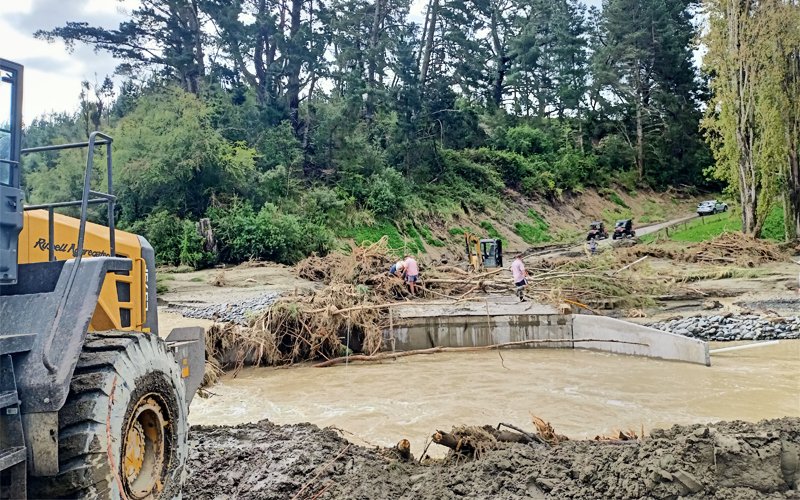
Remedial work on Mangatahi Road in Hastings following damage from severe weather events. Photo: Russell Roads
Reconnecting communities
For two days in mid-February, Cyclone Gabrielle battered Hawke’s Bay. The following day, a large crew from local civil engineering company Russell Roads was out in force, helping with the clean up, before being moved to the State Highway 2 Napier-Hastings Expressway – one of four major routes into Napier cut off by the cyclone.
Russell Roads Chief Executive Gavin O’Connor CMEngNZ IntPE(NZ) says it was expected that the Expressway could reopen later that day. Then it was discovered part of the road had been washed away below the tarseal, concealing a 6m void.
The team worked a 16-hour day, then a 14-hour day, to repair the road scouring and get the Expressway back open. In between, those from Napier went home to no electricity and cold water, before returning at 6am.
“The crew was incredible,” Gavin says.
The 80-strong company is still working on road repairs across the region. Gavin ensures the team take rest days, to avoid burnout. For some, the stress and strain is immense. One foreman lost everything when his house was washed away. Yet he’s still been working – overseeing vital repair works on State Highway 2.
One crew was “absolutely astounded” to receive a thank you note and bag of homemade cookies from Kererū School in Hastings.
“Building roads is what we do, but it’s different knowing you’re doing it to reconnect a community.”
A holistic approach
When EG caught up with Professor Regan Potangaroa CMEngNZ (Ngati Kahungunu ki Wairarapa) in March, the Auckland-based academic and structural engineer was desperate for news of his whānau land after Cyclone Gabrielle tore through the Wairarapa, destroying a large section of road and cutting off the remote community of Owāhanga.
The 17,000-acre Aohanga Incorporation farm is owned by Māori shareholders who whakapapa to that area. Based on aerial insurance photos, it seemed the farm had suffered severe damage. A $500,000 suspension bridge collapsed into the river, 7.5km of fencing was destroyed and the flat fertile land was covered in silt.
Regan says isolated rural communities need an early warning system, and better community preparedness for future resilience. That starts, he adds, with restoring road access.
Regan is a humanitarian aid expert, having completed more than 200 deployments in 22 countries since 1996. In the immediate aftermath of a disaster, engineers should be prepared to assist people first – “service before survey” – and it’s important to take a holistic approach.
“Resilience folds into social distress, family structures, disruption to education. It is much more complex than just fixing up a road, but fixing it is a huge start.”
This article was first published in the June 2023 issue of EG magazine.


